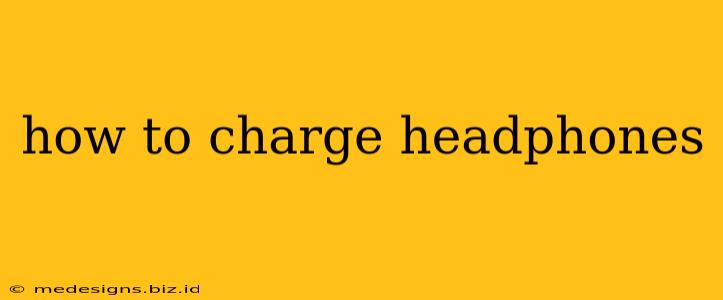Charging your headphones might seem straightforward, but different types of headphones have different charging methods. This guide covers various charging techniques to ensure you always have your audio companion ready to go. Knowing how to properly charge your headphones will extend their lifespan and prevent potential battery issues.
Understanding Your Headphones' Charging Method
Before you plug in, identify your headphone type. This is crucial because charging methods vary significantly:
1. Wired Headphones:
Wired headphones don't require charging. They receive power directly from the audio source (your phone, computer, etc.) via the connecting cable. However, some wired headphones may incorporate a battery for active noise cancellation (ANC) or other features. In such cases, consult your headphone’s manual for specific charging instructions.
2. Wireless Headphones (Bluetooth):
These are the most common type requiring charging. Wireless headphones use rechargeable batteries and usually charge via:
- USB-C: A widely adopted standard, offering fast charging capabilities.
- Micro-USB: An older standard, still found in some older models.
- Lightning Connector (Apple): Used exclusively for Apple devices and compatible headphones.
- Proprietary Connectors: Some manufacturers use unique connectors; always refer to your headphones' manual.
Step-by-Step Charging Instructions for Wireless Headphones
The exact steps might vary slightly depending on your headphones, but the general process is as follows:
- Locate the charging port: This is usually on the headphone case (for earbuds) or a designated area on the headband (for over-ear headphones).
- Connect the charging cable: Plug the appropriate end of your charging cable into the headphone's charging port and the other end into a power source (wall adapter, computer USB port, etc.).
- Charging indicator: Most headphones provide a visual or auditory indicator to show charging progress (e.g., a flashing light, a specific tone). Consult your manual for your specific model's indicators.
- Charging time: Charging times vary, ranging from a few hours to several hours depending on the battery capacity. Refer to your headphones’ manual for accurate charging time estimations.
- Fully charged indicator: Once fully charged, the charging indicator will usually turn off or change its pattern (e.g., from flashing to solid).
Troubleshooting Charging Issues
If your headphones aren't charging, try these troubleshooting tips:
- Check the cable: Ensure the charging cable is securely connected to both the headphones and the power source. Try a different cable if possible.
- Check the power source: Make sure your power source is working correctly. Try a different wall outlet or USB port.
- Clean the charging port: Dust or debris can obstruct the charging connection. Gently clean the charging port using a soft, dry brush or compressed air.
- Restart your headphones: Sometimes a simple restart can resolve minor software glitches affecting charging. Check your headphone's manual for instructions on how to restart.
- Consult the manual: Your headphone's manual contains detailed charging instructions and troubleshooting tips specific to your model.
Extending Your Headphones' Battery Life
- Avoid extreme temperatures: Exposure to extreme heat or cold can damage the battery and reduce its lifespan.
- Avoid complete discharges: Regularly charge your headphones before the battery completely drains.
- Proper storage: Store your headphones in a cool, dry place when not in use.
By following these tips and understanding your specific headphone model, you can ensure your headphones are always charged and ready to provide your favorite audio experience. Remember to always refer to your headphone's manual for the most accurate and detailed instructions.
